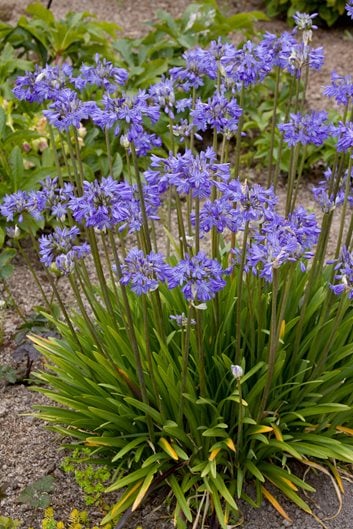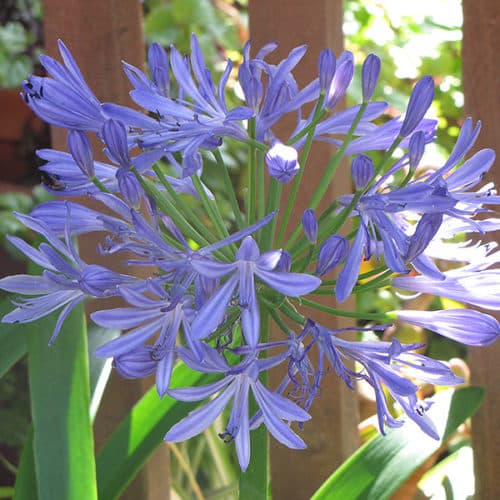Exactly how to Plant and Maintain Agapanthus in Your Yard
Exactly how to Plant and Maintain Agapanthus in Your Yard
Blog Article
Unleashing the Secret to Effective Agapanthus Farming: Advice for a Flourishing Garden
In the world of horticulture, cultivating agapanthus efficiently calls for a tactical method that incorporates different facets of plant treatment. By comprehending the nuances of agapanthus farming, one can produce an environment where these plants prosper and bloom perfectly.
Planting Agapanthus: Best Practices
When growing Agapanthus, proper dirt preparation is crucial for making sure successful development and development of these lovely flowers. Agapanthus, generally referred to as Lily of the Nile or African lily, thrives in well-draining dirt with a somewhat acidic to neutral pH level - Agapanthus. Prior to planting, it is critical to amend hefty clay soils with organic issue such as compost or peat moss to boost drainage and supply important nutrients for the plants
To grow Agapanthus, choose a place that obtains full sunlight to partial color, as this will promote healthy and balanced development and plentiful blooming. Dig a hole two times the size of the plant's origin round and put the Agapanthus at the same deepness it was previously expanding. Delicately backfill the opening with dirt, weighing down firmly to get rid of any air pockets around the roots.
Water the recently grown Agapanthus thoroughly and continue to maintain the dirt equally moist, particularly throughout the plant's energetic growing period. Agapanthus. Using a well balanced fertilizer once a month can even more sustain the plant's development and blooming. By following these best methods for growing Agapanthus, you can develop a stunning screen of these fascinating blossoms in your yard
Perfect Dirt Issues for Agapanthus
For optimal development and growing success of Agapanthus plants, ensuring the soil conditions are perfect is essential. Agapanthus prefers dirt that is abundant in nutrients, so incorporating a well balanced plant food during the growing period can promote healthy development and vivid blooms.

Watering and Fertilizing Tips
To guarantee healthy development and dynamic flowers, appropriate watering and feeding methods are crucial for effective Agapanthus farming. Agapanthus plants take advantage of normal watering, specifically throughout the expanding period. It is suggested to water deeply when a week, making sure the dirt is damp however not soaked. During heat or in pots, even more constant watering might be needed to stop the dirt from drying out completely.
When it comes to feeding Agapanthus, a well balanced fertilizer with equal components nitrogen, phosphorus, and potassium can be applied in the spring to advertise healthy and balanced growth and flowering. Slow-release plant foods are suitable for supplying nutrients gradually over an extended duration. Prevent over-fertilizing, as this can result in excessive foliage development at the cost of flowers.
Additionally, incorporating raw material like garden compost right into the soil can improve nutrient levels and boost soil framework, helping in the overall health and wellness of Source the Agapanthus plants. By following these watering and feeding suggestions, gardeners can guarantee their Agapanthus plants site prosper and produce stunning display screens of blossoms.
Pruning and Deadheading Techniques
Proper pruning and deadheading strategies play a crucial function in maintaining the health and looks of Agapanthus plants, enhancing the essential techniques of watering and fertilizing for effective cultivation. Trimming Agapanthus involves eliminating invested flower heads, dead or yellowing fallen leaves, and overall shaping of the plant to advertise far better growth. Deadheading, the procedure of getting rid of faded flowers, not just enhances the plant's appearance yet also motivates more growing.
When deadheading Agapanthus, it is a good idea to snip off the flower stem at the base utilizing sharp, tidy shears. This procedure reroutes the plant's power from seed production back into origin and vegetation development, promoting a healthier and a lot more durable plant. Routine deadheading can expand the growing period of Agapanthus and avoid self-seeding, which can cause overcrowding.
In regards to trimming, Agapanthus usually benefits from a light trim after blossoming to clean up the plant and Discover More Here motivate fresh growth. Cutting down the spent flower stems and removing any damaged or dead vegetation assists preserve the plant's vigor and general look. Nevertheless, it is necessary to stay clear of reducing into the crown of the plant, as this can compromise its wellness.

Protecting Agapanthus From Pests and Diseases
Executing reliable insect and disease monitoring methods is crucial to securing the health and vitality of Agapanthus plants in farming. One typical parasite that influences Agapanthus is the Agapanthus borer, a caterpillar that tunnels into the plant, causing damages to the blossoms and fallen leaves.
Along with pests, Agapanthus are at risk to diseases such as root rot and fungal fallen leave spots. These issues can often be stopped by ensuring appropriate water drainage and staying clear of overwatering. If signs of illness show up, affected parts of the plant must be without delay removed to avoid additional spread. Fungicides might additionally be made use of as a therapy action, following the manufacturer's instructions thoroughly. By staying alert and attending to bug and condition concerns immediately, garden enthusiasts can assist their Agapanthus prosper and prosper.

Final Thought
To conclude, effective farming of agapanthus needs correct planting methods, excellent soil conditions, ample watering and fertilizing, routine trimming and deadheading, and protection from conditions and pests. By complying with these pointers and tricks, garden enthusiasts can make certain a growing yard full of attractive agapanthus blooms. Agapanthus. Keep in mind to keep regular care and focus to detail to advertise the health and wellness and longevity of these sensational plants
When growing Agapanthus, correct dirt preparation is necessary for guaranteeing successful growth and advancement of these lovely blossoms.Water the freshly grown Agapanthus extensively and proceed to maintain the dirt equally wet, particularly during the plant's active growing period.For optimum development and growing success of Agapanthus plants, guaranteeing the soil conditions are perfect is important. When transplanting or planting Agapanthus, ensure the dirt is well-prepared to give the essential structure for the plants to develop themselves effectively. One common pest that affects Agapanthus is the Agapanthus borer, a caterpillar that passages right into the plant, triggering damage to the leaves and blossoms.
Report this page